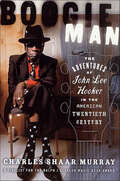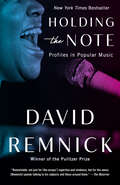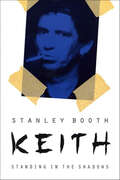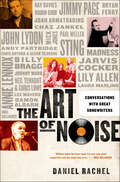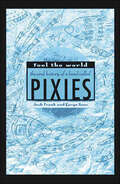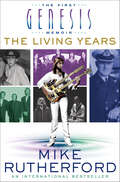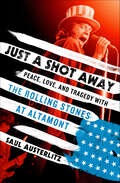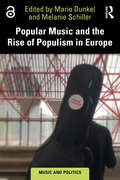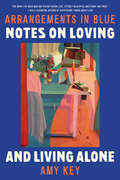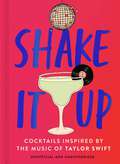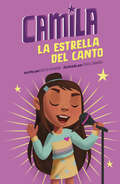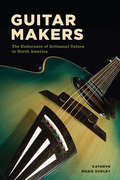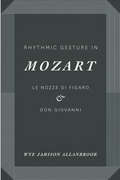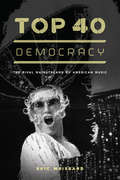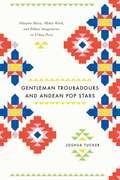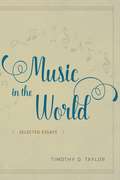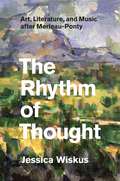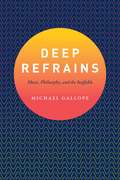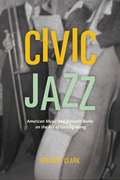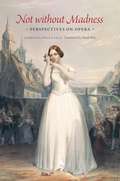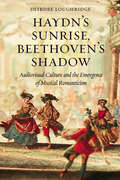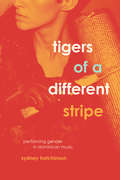- Table View
- List View
Boogie Man: The Adventures of John Lee Hooker in the American Twentieth Century
by Charles Shaar MurrayAcclaimed writer Charles Shaar Murray's Boogie Man is the authorized and authoritative biography of an extraordinary musician. Murray was given unparalleled access to Hooker, and he lets the man from Clarksdale, Mississippi, tell his own story. "Everything you read on album covers is not true, and every album reads different," he told Murray. Murray helps Hooker set the record straight, disentangling the myths and legends from truths so rock-ribbed that we understand, as if for the first time, why they have provided the source for a lifetime of unforgettable sound.Murray weaves together Hooker's life and music to reveal their indissoluble bonds. Yet Boogie Man is far more than merely an accomplished and brilliant biography of one man; it gives an account of an entire art form. Grounded in a time and place in American culture, the blues are universal, and in the hands of the greatest practitioners its power resides in the miracle of using despair to transcend it. "The preacher's mantle," Murray tells us, "passes to the bluesman." This bluesman traveled a hard road out of the American South, from obscurity to adulation and back-and back again. John Lee Hooker has seen it all and sung it all, and his music is both a living legacy and an American treasure. Here is the book that does him and his music full justice.
Holding the Note: Profiles in Popular Music
by David RemnickNEW YORK TIMES BEST SELLER • The Pulitzer Prize–winning journalist and editor of The New Yorker gathers his writing on some of the essential musicians of our time—intimate portraits of Leonard Cohen, Buddy Guy, Mavis Staples, Paul McCartney, Bruce Springsteen, Patti Smith, and more.The greatest popular songs, whether it&’s Aretha Franklin singing &“Respect&” or Bob Dylan performing &“Blind Willie McTell,&” have a way of embedding themselves in our memories. You remember a time and a place and a feeling when you hear that song again. In Holding the Note, David Remnick writes about the lives and work of some of the greatest musicians, songwriters, and performers of the past fifty years.He portrays a series of musical lives and their unique encounters with the passing of that essential element of music: time. From Cohen&’s performing debut, when his stage fright was so debilitating he couldn&’t get through &“Suzanne,&” to Franklin&’s iconic mink-drop at the Kennedy Center, Holding the Note delivers a view of some of the greatest creative minds of our time written with a lifetime&’s passionate attachment to music that has shaped us all.
Keith: Standing in the Shadows
by Stanley BoothKeith is the biography of Keith Richards, written by one of his old friends, Stanley Booth. Drawing on extensive, in-depth interviews, the book explores Richards' relationship with Mick Jagger and the Stones, his views on his evolving craft, his experiences in the London music scene, and much more. Keith offers a personal study of the Rolling Stones legend, an "intimate portrait of one of the great molders of contemporary pop music" (Booklist).
The Art of Noise: Conversations with Great Songwriters
by Daniel RachelTHE ART OF NOISE offers an unprecedented collection of insightful, of-the-moment conversations with twenty-seven great British songwriters and composers. They discuss everything from their individual approaches to writing, to the inspiration behind their most successful songs, to the techniques and methods they have independently developed to foster their creativity. Contributors include: Sting * Ray Davies * Robin Gibb * Jimmy Page * Joan Armatrading * Noel Gallagher * Lily Allen * Annie Lennox * Damon Albarn * Noel Gallagher * Laura Marling * Paul Weller * Johnny Marr * and many more Musician-turned-author Daniel Rachel approaches each interview with an impressive depth of understanding—of the practice of songwriting, but also of each musician's catalog. The result is a collection of conversations that's probing, informed, and altogether entertaining—what contributor Noel Gallagher called "without doubt the finest book I've ever read about songwriters and the songs they write." The collected experience of these songwriters makes this book the essential word of songwriting—as spoken by the songwriters themselves.
Fool the World: The Oral History of a Band Called Pixies
by Josh Frank Caryn GanzIt's the 1980s and the rock landscape is littered with massive hair, synthesizers, and monster riffs, but there is an alternative being born in the sleepy East of America-we just don't know it yet.Before the Internet, MTV, and iPods provided far-off music fans with information and communities-and before Nirvana-kids across the world grew up in relative isolation, dependent on mix tapes and self-created art to slowly spread scenes and trends. It was under these conditions that four young musicians found one another in Boston, Massachusetts, and started a band called Pixies.During their initial seven-year career, Pixies would play some of Europe's most gigantic festivals, keep the press guessing, and cultivate a fervid international fan base hungry for more and more of their unique surf punk. The band worked fast, cranking out four albums at a breakneck pace, but ultimately pressures and personality clashes took their toll: Pixies broke up just as bands were singing their praises as the rock'n'roll innovators. For twelve years, a Pixies reunion seemed impossible, but a sudden announcement in 2004 proclaimed the unthinkable-Pixies were getting back together. Their extremely successful reunion tour finally gave the group something they'd always lacked in their homeland: proof that their bone-rattling music had left an indelible impact. Fool the World tells Pixies' story in the words of those who lived it, from the band members to studio owners, from A&R executives, producers, and visual artists who worked with them to admirers of their music, such as Bono, PJ Harvey, Beck, and Perry Farrell. With new cartoons by Trompe Le Monde illustrator Steven Appleby, Fool the World is a complete journey through the life, death, and rebirth of one of the most influential bands of all time.
The Living Years: The First Genesis Memoir
by Mike RutherfordThe story of Genesis is the rock legend of how a humble schoolboy band grew into a group of global superstars. At its center stood Mike Rutherford, driving the music from pioneering prog rock to chart-topping hits. Now for the first time, he tells the remarkable inside story of Genesis and his own band, Mike + The Mechanics.Against the rhythm of drink, drugs, and lineup changes, Mike's father, a World War II naval officer, always stood in the background. He would watch Genesis grow, supporting them from the very beginning when they toured Britain in the back of a bread van. Through extreme highs and lows, loyal Captain Rutherford was always there, earplugs at the ready.But when his father suddenly died, Mike was forced to reexamine their relationship and only then began to understand how much their lives had overlapped. The Living Years is a revealing memoir of the relationship between father and son and the story of how music, families, and friendship combine.
Just a Shot Away: Peace, Love, and Tragedy with the Rolling Stones at Altamont
by Saul Austerlitz“The most blisteringly impassioned music book of the season.” —New York Times Book ReviewA thrilling account of the Altamont Festival—and the dark side of the ‘60s.If Woodstock tied the ideals of the '60s together, Altamont unraveled them. In Just a Shot Away, writer and critic Saul Austerlitz tells the story of “Woodstock West,” where the Rolling Stones hoped to end their 1969 American tour triumphantly with the help of the Grateful Dead, the Jefferson Airplane, and 300,000 fans. Instead the concert featured a harrowing series of disasters, starting with the concert’s haphazard planning. The bad acid kicked in early. The Hells Angels, hired to handle security, began to prey on the concertgoers. And not long after the Rolling Stones went on, an 18-year-old African-American named Meredith Hunter was stabbed by the Angels in front of the stage.The show, and the Woodstock high, were over. Austerlitz shows how Hunter’s death came to symbolize the end of an era while the trial of his accused murderer epitomized the racial tensions that still underlie America. He also finds a silver lining in the concert in how Rolling Stone’s coverage of it helped create a new form of music journalism, while the making of the movie about Altamont, Gimme Shelter, birthed new forms of documentary. Using scores of new interviews with Paul Kantner, Jann Wenner, journalist John Burks, filmmaker Joan Churchill, and many members of the Rolling Stones' inner circle, as well as Meredith Hunter's family, Austerlitz shows that you can’t understand the ‘60s or rock and roll if you don’t come to grips with Altamont.
Popular Music and the Rise of Populism in Europe (Music and Politics)
by Melanie Schiller Mario DunkelThis book focuses on the role of popular music in the rise of populism in Europe, centring on the music-related processes of sociocultural normalisation and the increasing prevalence of populist discourses in contemporary society. In its innovative combination of approaches drawing from (ethno)musicology, sociology, and political science, as well as media and cultural studies, this book develops a culture-oriented approach to populism. Based on shared research questions, an original theoretical framework and a combination of innovative methodologies that pay attention to the specific socio-historical contexts, taking into account musical material as well as processes of reception, the five chapters in this volume offer detailed analyses of the nexus of popular music and populism in Hungary, Italy, Austria, Sweden and Germany. All of these countries have seen a marked increase in populist parties and discourses over the last years, as well as significant interactions between populism and popular music. This book will be essential reading for those investigating popular music as a crucial aspect in the study of populism as a cultural phenomenon in Europe.The Open Access version of this book, available at http://www.taylorfrancis.com, has been made available under a Creative Commons [Attribution-Non Commercial-No Derivatives (CC-BY-NC-ND)] 4.0 license.
Arrangements in Blue: Notes on Loving and Living Alone
by Amy Key"[Arrangements in Blue] reflects on a life spent as a single woman and how that affects friendships, freedom, domesticity, family, sexuality, the psyche, the self. It observes things about being alone that I have never seen or heard articulated before.... beautiful, effortless.... I haven’t been so obsessed with a book in a long time." —Dolly Alderton “The poet Amy Key’s first book might be the most hyped memoir of 2023 (or at least a close second to Spare)… This raw, gorgeous, pulsing memoir is…the harbinger of a real talent.” —Laura Hackett, Sunday Times [UK] Amy Key—a writer “of rare and strange magic” (Guardian)—probes the art of living without romance in this soul-stirring debut. When British poet Amy Key was growing up, she envisioned a life shaped by love—and Joni Mitchell’s album Blue was her inspiration. “Blue became part of my language of intimacy,” she writes, recalling the dozens of times she played the record as a teen, “an intimacy of disclosure, vulnerability, unadorned feeling that I thought I’d eventually share with a romantic other.” As the years ticked by, she held on to this very specific idea of romance like a bottle of wine saved for a special occasion. But what happens when the romance we are all told will give life meaning never presents itself? Now single in her forties, Key explores the sweeping scales of romantic feeling as she has encountered them, using the album Blue as an expressive anchor: from the low notes of loss and unfulfilled desire—punctuated by sharp, discordant feelings of jealousy and regret—to the deep harmony of friendship, and the crescendos of sexual attraction and self-realization. Finding solace in Mitchell’s songs, Key plumbs Blue’s track list for themes that resonate with her heart’s seasons. Listening to the song “California,” she explores the mixed emotions that come with traveling alone in a world built for couples; she juxtaposes the lonely lyrics of “My Old Man” with the pleasurable art of curating a perfect apartment for one; and with the utmost tenderness, she parses out her decision to not have children with the eloquent “Little Green.” Mapping the evolution of her early conceptions of love through her adulthood, Key offers a tender and nakedly candid celebration of the many forms of intimacy that often go unnoticed. An essential work for both the single and the partnered, Arrangements in Blue is a bold manual for building a life on your own terms.
Shake It Up: Delicious cocktails inspired by the music of Taylor Swift
by WelbeckTake a trip into the Taylor-verse with this collection of delicious cocktail recipes inspired by the songs of Taylor Swift. Featuring 65 cocktail recipes alongside top tips and stunning Taylor-inspired illustrations, this is a celebration of pop music's finest songbook and the perfect collection for the Swiftie in your life.Cocktails include:I Knew You Were DoubleWe Are Never Ever Getting Back TequilaMr. Perfectly WineNew Rum-anticsGetaway SidecarCruel SlammerFizz The Damn SeasonThe Last Great American DaiquiriAnd many more.
Camila la estrella del canto (Camila la estrella)
by Alicia SalazarLa siguiente oportunidad para Camila de convertirse en una estrella es ¡un concurso de canto! El ganador necesitará la canción perfecta y mucha práctica, y por suerte, Camila cuenta con las dos cosas. ¿Será que los nervios se apoderarán de ella, o descubrirá un arma secreta para mantenerse calmada y segura?
Shake It Up: Delicious cocktails inspired by the music of Taylor Swift
by WelbeckTake a trip into the Taylor-verse with this collection of delicious cocktail recipes inspired by the songs of Taylor Swift. Featuring 65 cocktail recipes alongside top tips and stunning Taylor-inspired illustrations, this is a celebration of pop music's finest songbook and the perfect collection for the Swiftie in your life.Cocktails include:I Knew You Were DoubleWe Are Never Ever Getting Back TequilaMr. Perfectly WineNew Rum-anticsGetaway SidecarCruel SlammerFizz The Damn SeasonThe Last Great American DaiquiriAnd many more.
The Story of Selena Quintanilla: An Inspiring Biography for Young Readers (The Story of Biographies)
by Gloria ArjonaDiscover the life Selena Quintanilla—a story about breaking down barriers in music, for kids ages 6 to 9Selena Quintanilla was the queen of Tejano music. Before she became a star, Selena was a charismatic young girl who loved singing and performing. She made a lot of sacrifices to become a famous musician, rehearsing her songs and dance moves for hours at a time. Her hard work paid off—she became the first 15-year-old girl to win a Tejano music award and went on to break many records during her career. Explore how she went from being a talented girl growing up in Texas to a fashion icon and a world-famous singer.Independent reading—This Selena biography is broken down into short chapters and simple language so kids 6 to 9 can read and learn on their own.Critical thinking—Kids will learn the Who, What, Where, When, Why, and How of Selena's life, find definitions of new words, discussion questions, and more. A lasting legacy—Kids will find out how Selena changed the world of music and why she continues to be a role model for many women and people of color around the globe.How will Selena's big spirit and passion for music inspire the child in your life?Discover activists, artists, athletes, and more from across history with the rest of the Story Of series, including famous figures like: Marie Curie, Amelia Earhart, Frida Kahlo, Helen Keller, and Jane Goodall.
Let's Play an Instrument: A Music Book for Kids
by Rachelle BurkIntroduce kids to music, instruments, and rhythm with this adorable picture book for ages 3 to 5Get little toes tapping with this delightful music book for toddlers! On every page, simple language and big, beautiful illustrations teach little ones about woodwind, string, brass, and percussion instruments. They'll learn what each one is called, how it works, the sounds it makes, and why it helps make music so amazing!How music is made—Explore all the sounds instruments can create, from the deep rumble of the bass to the jingle of the tambourine.A magical, musical story time—Make reading aloud a musical adventure with rhythmic language that preschool and kindergarten kids will want to read again and again.Instrumental illustrations—This book about music features colorful, full-page illustrations convey the fun of playing music and are sure to delight kids and parents alike.Let little ones take their first steps in music with Let's Play an Instrument.
Guitar Makers: The Endurance of Artisanal Values in North America
by Kathryn Marie DudleyIt whispers, it sings, it rocks, and it howls. It expresses the voice of the folk—the open road, freedom, protest and rebellion, youth and love. It is the acoustic guitar. And over the last five decades it has become a quintessential American icon. Because this musical instrument is significant to so many—in ways that are emotional, cultural, and economic—guitar making has experienced a renaissance in North America, both as a popular hobby and, for some, a way of life. In Guitar Makers, Kathryn Marie Dudley introduces us to builders of artisanal guitars, their place in the art world, and the specialized knowledge they’ve developed. Drawing on in-depth interviews with members of the lutherie community, she finds that guitar making is a social movement with political implications. Guitars are not simply made—they are born. Artisans listen to their wood, respond to its liveliness, and strive to endow each instrument with an unforgettable tone. Although professional luthiers work within a market society, Dudley observes that their overriding sentiment is passion and love of the craft. Guitar makers are not aiming for quick turnover or the low-cost reproduction of commodities but the creation of singular instruments with unique qualities, and face-to-face transactions between makers, buyers, and dealers are commonplace. In an era when technological change has pushed skilled artisanship to the margins of the global economy, and in the midst of a capitalist system that places a premium on ever faster and more efficient modes of commerce, Dudley shows us how artisanal guitar makers have carved out a unique world that operates on alternative, more humane, and ecologically sustainable terms.
Rhythmic Gesture in Mozart: Le Nozze di Figaro & Don Giovanni
by Wye Jamison AllanbrookWye Jamison Allanbrook’s widely influential Rhythmic Gesture in Mozart challenges the view that Wolfgang Amadeus Mozart’s music was a “pure play” of key and theme, more abstract than that of his predecessors. Allanbrook’s innovative work shows that Mozart used a vocabulary of symbolic gestures and musical rhythms to reveal the nature of his characters and their interrelations. The dance rhythms and meters that pervade his operas conveyed very specific meanings to the audiences of the day.
Top 40 Democracy: The Rival Mainstreams of American Music
by Eric WeisbardIf you drive into any American city with the car stereo blasting, you’ll undoubtedly find radio stations representing R&B/hip-hop, country, Top 40, adult contemporary, rock, and Latin, each playing hit after hit within that musical format. American music has created an array of rival mainstreams, complete with charts in multiple categories. Love it or hate it, the world that radio made has steered popular music and provided the soundtrack of American life for more than half a century. In Top 40 Democracy, Eric Weisbard studies the evolution of this multicentered pop landscape, along the way telling the stories of the Isley Brothers, Dolly Parton, A&M Records, and Elton John, among others. He sheds new light on the upheavals in the music industry over the past fifteen years and their implications for the audiences the industry has shaped. Weisbard focuses in particular on formats—constructed mainstreams designed to appeal to distinct populations—showing how taste became intertwined with class, race, gender, and region. While many historians and music critics have criticized the segmentation of pop radio, Weisbard finds that the creation of multiple formats allowed different subgroups to attain a kind of separate majority status—for example, even in its most mainstream form, the R&B of the Isley Brothers helped to create a sphere where black identity was nourished. Music formats became the one reliable place where different groups of Americans could listen to modern life unfold from their distinct perspectives. The centers of pop, it turns out, were as complicated, diverse, and surprising as the cultural margins. Weisbard’s stimulating book is a tour de force, shaking up our ideas about the mainstream music industry in order to tease out the cultural importance of all performers and songs.
Gentleman Troubadours and Andean Pop Stars: Huayno Music, Media Work, and Ethnic Imaginaries in Urban Peru (Chicago Studies In Ethnomusicology Ser.)
by Joshua TuckerExploring Peru’s lively music industry and the studio producers, radio DJs, and program directors that drive it, Gentleman Troubadours and Andean Pop Stars is a fascinating account of the deliberate development of artistic taste. Focusing on popular huayno music and the ways it has been promoted to Peru’s emerging middle class, Joshua Tucker tells a complex story of identity making and the marketing forces entangled with it, providing crucial insights into the dynamics among art, class, and ethnicity that reach far beyond the Andes. Tucker focuses on the music of Ayacucho, Peru, examining how media workers and intellectuals there transformed the city’s huayno music into the country’s most popular style. By marketing contemporary huayno against its traditional counterpart, these agents, Tucker argues, have paradoxically reinforced ethnic hierarchies at the same time that they have challenged them. Navigating between a burgeoning Andean bourgeoisie and a music industry eager to sell them symbols of newfound sophistication, Gentleman Troubadours and Andean Pop Stars is a deep account of the real people behind cultural change.
Music in the World: Selected Essays
by Timothy D. TaylorIn music studies, Timothy D. Taylor is known for his insightful essays on music, globalization, and capitalism. Music in the World is a collection of some of Taylor’s most recent writings—essays concerned with questions about music in capitalist cultures, covering a historical span that begins in the late nineteenth and early twentieth centuries and continues to the present. These essays look at shifts in the production, dissemination, advertising, and consumption of music from the industrial capitalism of the nineteenth century to the globalized neoliberal capitalism of the past few decades. In addition to chapters on music, capitalism, and globalization, Music in the World includes previously unpublished essays on the continuing utility of the concept of culture in the study of music, a historicization of treatments of affect, and an essay on value and music. Taken together, Taylor’s essays chart the changes in different kinds of music in twentieth- and twenty-first-century music and culture from a variety of theoretical perspectives.
The Rhythm of Thought: Art, Literature, and Music after Merleau-Ponty
by Jessica WiskusBetween present and past, visible and invisible, and sensation and idea, there is resonance—so philosopher Maurice Merleau-Ponty argued and so Jessica Wiskus explores in The Rhythm of Thought. Holding the poetry of Stéphane Mallarmé, the paintings of Paul Cézanne, the prose of Marcel Proust, and the music of Claude Debussy under Merleau-Ponty’s phenomenological light, she offers innovative interpretations of some of these artists’ masterworks, in turn articulating a new perspective on Merleau-Ponty’s philosophy. More than merely recovering Merleau-Ponty’s thought, Wiskus thinks according to it. First examining these artists in relation to noncoincidence—as silence in poetry, depth in painting, memory in literature, and rhythm in music—she moves through an array of their artworks toward some of Merleau-Ponty’s most exciting themes: our bodily relationship to the world and the dynamic process of expression. She closes with an examination of synesthesia as an intertwining of internal and external realms and a call, finally, for philosophical inquiry as a mode of artistic expression. Structured like a piece of music itself, The Rhythm of Thought offers new contexts in which to approach art, philosophy, and the resonance between them.
Deep Refrains: Music, Philosophy, and the Ineffable
by Michael GallopeWe often say that music is ineffable, that it does not refer to anything outside of itself. But if music, in all its sensuous flux, does not mean anything in particular, might it still have a special kind of philosophical significance? In Deep Refrains, Michael Gallope draws together the writings of Arthur Schopenhauer, Friedrich Nietzsche, Ernst Bloch, Theodor Adorno, Vladimir Jankélévitch, Gilles Deleuze, and Félix Guattari in order to revisit the age-old question of music’s ineffability from a modern perspective. For these nineteenth- and twentieth-century European philosophers, music’s ineffability is a complex phenomenon that engenders an intellectually productive sense of perplexity. Through careful examination of their historical contexts and philosophical orientations, close attention to their use of language, and new interpretations of musical compositions that proved influential for their work, Deep Refrains forges the first panoptic view of their writings on music. Gallope concludes that music’s ineffability is neither a conservative phenomenon nor a pious call to silence. Instead, these philosophers ask us to think through the ways in which music’s stunning force might address, in an ethical fashion, intricate philosophical questions specific to the modern world.
Civic Jazz: American Music and Kenneth Burke on the Art of Getting Along
by Gregory ClarkJazz is born of collaboration, improvisation, and listening. In much the same way, the American democratic experience is rooted in the interaction of individuals. It is these two seemingly disparate, but ultimately thoroughly American, conceits that Gregory Clark examines in Civic Jazz. Melding Kenneth Burke’s concept of rhetorical communication and jazz music’s aesthetic encounters with a rigorous sort of democracy, this book weaves an innovative argument about how individuals can preserve and improve civic life in a democratic culture. Jazz music, Clark argues, demonstrates how this aesthetic rhetoric of identification can bind people together through their shared experience in a common project. While such shared experience does not demand agreement—indeed, it often has an air of competition—it does align people in practical effort and purpose. Similarly, Clark shows, Burke considered Americans inhabitants of a persistently rhetorical situation, in which each must choose constantly to identify with some and separate from others. Thought-provoking and path-breaking, Clark’s harmonic mashup of music and rhetoric will appeal to scholars across disciplines as diverse as political science, performance studies, musicology, and literary criticism.
Not without Madness: Perspectives on Opera
by Fabrizio Della SetaOpera often seems to arouse either irrational enthusiasm or visceral dislike. Such madness, as Goethe wrote, is indispensable in all theater, and yet in practice, sentiment and passion must be balanced by sense and reason. Exploring this tension between madness and reason, Not without Madness presents new analytical approaches to thinking about eighteenth- and nineteenth-century opera through the lenses of its historical and cultural contexts. In these twelve essays, Fabrizio Della Seta explores the concept of opera as a dramatic event and an essential moment in the history of theater. Examining the meaning of opera and the devices that produce and transmit this meaning, he looks at the complex verbal, musical, and scenic mechanisms in parts of La sonnambula, Ernani, Aida, Le nozze di Figaro, Macbeth, and Il trovatore. He argues that approaches to the study of opera must address performance, interpretation, composition, reception, and cultural ramifications. Purely musical analysis does not make sense unless we take into account music’s dramatic function. Containing many essays available for the first time in English, Not without Madness bridges recent divisions in opera studies and will attract musicologists, musicians, and opera lovers alike.
Haydn’s Sunrise, Beethoven’s Shadow: Audiovisual Culture and the Emergence of Musical Romanticism
by Deirdre LoughridgeThe years between roughly 1760 and 1810, a period stretching from the rise of Joseph Haydn’s career to the height of Ludwig van Beethoven’s, are often viewed as a golden age for musical culture, when audiences started to revel in the sounds of the concert hall. But the latter half of the eighteenth century also saw proliferating optical technologies—including magnifying instruments, magic lanterns, peepshows, and shadow-plays—that offered new performance tools, fostered musical innovation, and shaped the very idea of “pure” music. Haydn’s Sunrise, Beethoven’s Shadow is a fascinating exploration of the early romantic blending of sight and sound as encountered in popular science, street entertainments, opera, and music criticism. Deirdre Loughridge reveals that allusions in musical writings to optical technologies reflect their spread from fairgrounds and laboratories into public consciousness and a range of discourses, including that of music. She demonstrates how concrete points of intersection—composers’ treatments of telescopes and peepshows in opera, for instance, or a shadow-play performance of a ballad—could then fuel new modes of listening that aimed to extend the senses. An illuminating look at romantic musical practices and aesthetics, this book yields surprising relations between the past and present and offers insight into our own contemporary audiovisual culture.
Tigers of a Different Stripe: Performing Gender in Dominican Music (Chicago Studies In Ethnomusicology Ser.)
by Sydney HutchinsonTigers of a Different Stripe takes readers inside the unique world of merengue típico, a traditional music of the Dominican Republic. While in most genres of Caribbean music women usually participate as dancers or vocalists, in merengue típico they are more often instrumentalists and even bandleaders—something nearly unheard of in the macho Caribbean music scene. Examining this cultural phenomenon, Sydney Hutchinson offers an unexpected and fascinating account of gender in Dominican art and life. Drawing on over a decade of fieldwork in the Dominican Republic and New York among musicians, fans, and patrons of merengue típico—not to mention her own experiences as a female instrumentalist—Hutchinson details a complex nexus of class, race, and artistic tradition that unsettles the typical binary between the masculine and feminine. She sketches the portrait of the classic male figure of the tíguere, a dandified but sexually aggressive and street-smart “tiger,” and she shows how female musicians have developed a feminine counterpart: the tíguera, an assertive, sensual, and respected female figure who looks like a woman but often plays and even sings like a man. Through these musical figures and studies of both straight and queer performers, she unveils rich ambiguities in gender construction in the Dominican Republic and the long history of a unique form of Caribbean feminism.
